 Travel
Travel  Travel
Travel  Creepy
Creepy 10 Haunted Places in Alabama
 History
History Top 10 Tragic Facts about England’s 9 Days Queen
 Food
Food 10 Weird Foods Inspired by Your Favorite Movies
 Religion
Religion 10 Mind-Blowing Claims and Messages Hidden in the Bible Code
 Facts
Facts 10 Things You Never Knew about the History of Gambling
 Weird Stuff
Weird Stuff 10 Cool and Creepy Facts about Collecting Tears
 Humans
Humans The Ten Most Lethal Gunslingers of the Old West
 Misconceptions
Misconceptions 10 Phony Myths and Urban Legends That Just Won’t Die
 History
History 10 Amazing Roman Epitaphs
 Travel
Travel Top 10 Religious Architectural Marvels
 Creepy
Creepy 10 Haunted Places in Alabama
 History
History Top 10 Tragic Facts about England’s 9 Days Queen
Who's Behind Listverse?

Jamie Frater
Head Editor
Jamie founded Listverse due to an insatiable desire to share fascinating, obscure, and bizarre facts. He has been a guest speaker on numerous national radio and television stations and is a five time published author.
More About Us Food
Food 10 Weird Foods Inspired by Your Favorite Movies
 Religion
Religion 10 Mind-Blowing Claims and Messages Hidden in the Bible Code
 Facts
Facts 10 Things You Never Knew about the History of Gambling
 Weird Stuff
Weird Stuff 10 Cool and Creepy Facts about Collecting Tears
 Humans
Humans The Ten Most Lethal Gunslingers of the Old West
 Misconceptions
Misconceptions 10 Phony Myths and Urban Legends That Just Won’t Die
 History
History 10 Amazing Roman Epitaphs
10 Strange And Terrifying Religious Shrines From Asia
Ever since our ancient ancestors said goodbye to their first loved ones, we’ve wondered what happens next. And the human imagination being what it is, we’ve come up with a lot of really disturbing possibilities. So it goes without saying that shrines and temples can get pretty dark, especially those that are trying to warn us of what’s going to happen if we stray.
10Dongyue Temple
China
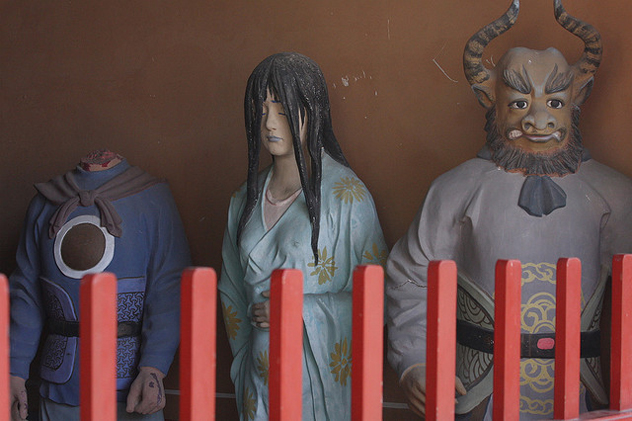
Dongyue Temple dates back to 1319, and it’s one of the largest Taoist temples in Beijing. It’s also one of the creepiest.
It’s home to the Beijing Folklore Museum, which was opened in 1999 and commemorates a number of traditions throughout Chinese culture. The festivals and demonstrations that go on almost year-round mean that there’s a lot of blessing going on at the temple and at the museum. You can walk the blessing road or participate in the many ceremonies held there.
All that blessing is a good thing, because the temple also shows you exactly what’s going to happen to you if you don’t behave.
The main yard, which is accessible via the Happiness Road, has two huge pavilions that were built as memorials to two of the Qing Dynasty emperors. There are also 72 small rooms, each one representing one of the departments of hell. The namesake of the temple, Dong Yue, is, after all, the one responsible for overseeing all 18 layers of hell and the 76 departments within them.
And it’s all very bureaucratic. You can take a peek at the Department of Pity and Sympathy, which is filled with little clay statues of beggars waiting for their appeal. The Department for Accumulating Wealth is packed and, of course, there’s also a Department for Implementing 15 Kinds of Violent Death.
There are donation and collection boxes outside each one of the cubicles if the garishly painted, absolutely terrifying statues are able to convince you that it won’t hurt to leave a little something behind for some goodwill from the overseers.
9Goa Lawah Temple
Indonesia
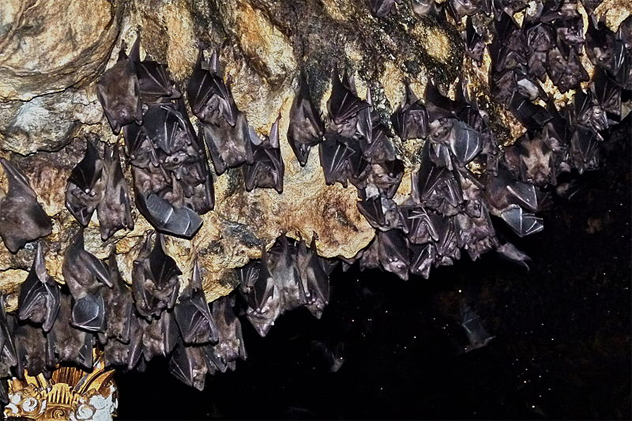
Not a fan of bats? Then you might want to give Bali’s Goa Lawah Temple a miss, because all that chirping is the sound of thousands of the little guys.
Goa Lawah means “bat cave,” and it’s also the site of a Hindu temple built in the 11th century. One of the earliest of the country’s Hindu temples, it’s grown into a massive temple complex where the faithful still go to leave offerings—especially before going on a trip. Many of the offerings are of fruit, so it’s not surprising that you can usually see the nectar bats that cluster around the mouth of the cave. The bats were also once an important part of the lives of the priests who lived at the temple, as it was thought that the frequency and pitch of their chirping helped to focus their minds during meditation.
According to the legend, the cave—which no one has ever explored in its entirety—was once the hiding spot of a prince. The caves led him away from his pursuers and to safety at Mount Agung’s Besakih Temple, but it’s also been said to lead to a few other temple locations. Supposedly, whenever Mount Agung erupts, ash pours from Goa Lawah.
And if you believe the legends, the bats aren’t the only unsettling residents in the cave. It’s also rumored to be the home of the Hindu snake Vasuki, the serpent seen in the company of Shiva. He guards the healing waters that are deep within the cave, deeper than has ever been explored. When he’s hungry, he comes out to eat some of the bats.
8Wat Phumin
Thailand
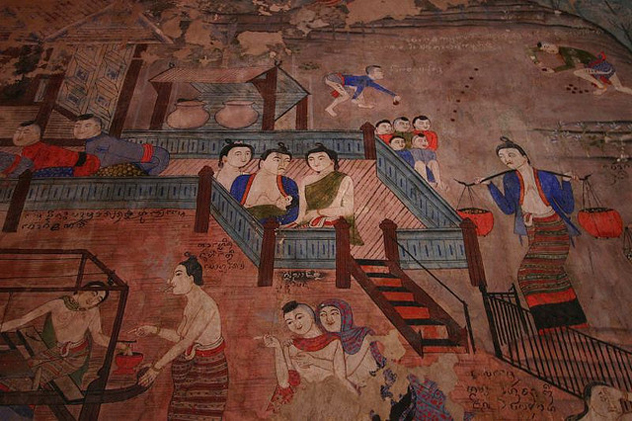
Wat Phumin is a Buddhist temple in Nan, Thailand, and it’s absolutely beautiful. There are four entrances to the temple, and each one holds a statue of Buddha. The interior is intricately decorated, the walls covered with murals that provide an invaluable look into daily life. That’s only the main temple, though, and along with a two-story library for religious texts, there’s also a squat little domed building that looks like a place you really don’t want to walk into.
Inside the dome are a series of life-size dioramas that show just what’s going to happen to those who stray from the Buddhist path. Hell is a temporary concept in Buddhist teachings, but there’s a handful of different interpretations as to what happens there. Some early scriptures describe it as one of the six realms of existence where souls go to suffer through rebirths after everything from being eaten alive to being cut into pieces, each time reborn to the same torment. Another text likens each realm to parts of our society here—hell is the spiritual equivalent of prison.
And you see it all in the hell dome. Animal-headed people are boiled alive in pots, victims are doused with hot oil, and there’s even a woman impaled on a tree with a bird eating pieces of her head. An overseer sits on a pile of skulls, and all the figures are done badly enough to be unsettling and well enough to be terrifying. It’s all in sharp contrast to the murals in the heavenly part of the temple, where merchants stare into the the eyes of their wives, musicians play instruments, and no one is getting boiled alive. The message is absolutely clear.
7Huashan Teahouse
China
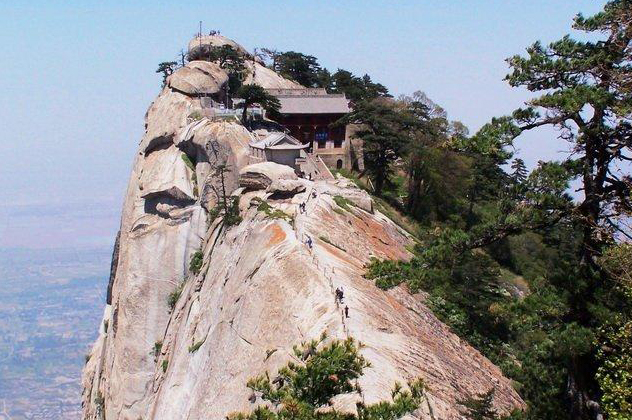
There are no unsettling depictions of hell here, but the Huashan Teahouse is absolutely terrifying for a completely different reason. Contrary to the popular saying, getting there is definitely not half the fun.
Mount Huashan has been a sacred place for centuries. Scattered across the mountain’s peaks are a series of shrines and temples, and even the mountains themselves have an important place in religious lore. Taoist beliefs interpret wealth based on how many species of plants and animals are found in an area, and that makes the mountain the embodiment of wealth. That’s not up for debate, either, as when it comes to a narrow category like medicinal plants, there are 474 different types of them. It’s the place that gods have come to touch the Earth, to bring their magic, and to perform miracles; it’s also the place where emperors have gone to worship those gods. And the path to get there claims about 100 lives every year.
The path starts out with some steep stairs, but that’s cake. It soon turns into nothing more than broken boards nailed into the side of a sheer cliff face with no safety railings and only a chain to hold onto. In some places, there aren’t even boards, and you’d better be prepared to make your way across some narrow iron bars or use a chain to climb the sheer cliff face using nothing but footholds chiseled into the rock. When you make it to the top of the southern mountain peak, you’ll have the chance to have tea in a converted monastery that might have some of the best views around. Good luck getting back down.
6Zenkoji Temple
Japan
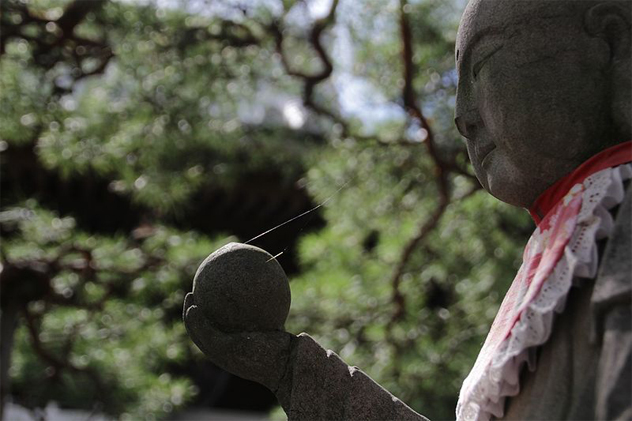
Nagano’s Zenkoji Temple is ancient. During the sixth century, Buddhism was still something of an unaccepted, upstart religion, and those who practiced it weren’t necessarily doing so with anyone’s approval. The whole thing was a bit hush-hush, and in 654, a statue that had been carved in India and brought into the country was installed, in secret, in the temple. Called a “hibutsu,” or “hidden Buddha,” the statue was originally brought out of its place behind the altar for special occasions until wear and tear on it necessitated creating a replica that was used instead. That was in the 13th century, and the replica is put on display every seven years (a similar statue is pictured above).
The real statue remains hidden. The last time it was examined was in 1720, when rumors started circulating that the box was empty. There’s another rumor that says that the statue is warm, and that touching it is like touching a living thing. When visitors touch a pillar in front of the altar, it’s said they’re touching the image by extension.
But that’s not the unsettling part.
There’s a tunnel beneath the altar, and not only is it the closest anyone—including the monks—can get to the hidden image of Buddha, it’s completely pitch black. It’s supposed to symbolize the journey that all souls go through in death and rebirth. It’s also a way for laypeople to experience the induction of new members of the priestly caste. After removing your shoes, you’re allowed into the completely dark tunnel. Somewhere along the way, hidden in the darkness, there’s a key to paradise that lucky (or blessed) visitors can try to find. If you’ve never been in a pitch-black tunnel with no way to gauge your surroundings or to even know what the lay of the room is, it’s a terrifying experience.
5The Snake Pagoda
Myanmar
Snakes not your thing? The pagoda at Paleik won’t be your thing, either.
Its official name is Yadana Labamuni Hsu-taungpye Paya, but most just call it the Snake Pagoda—and for good reason. The temple itself dates back to either the 11th or the 15th century (history’s not quite clear on just when it was built), but it was only in the 1970s that the snakes showed up. Three pythons made their way into the temple from the surrounding forest and decided that they were going to spend their days sleeping inside the pagoda, so they draped themselves around the images of Buddha.
The monks allowed them to stay, because who wants to argue with a python?
One of the pythons in particular is extremely large, about as big around as a man’s thigh and about 5 meters (16.5 ft) long. According to folklore, he’s particularly sacred, as he’s said to be the reincarnation of one of the temple’s abbots.
Today the snakes are a huge tourist attraction for the area, which also includes 325 stupas. And the snakes are, by all accounts, harmless. They’re well-fed and well-looked after, with the brave able to pose with them (and their handlers) for photos. You can also attend daily ceremonies in which the revered snakes are washed and fed.
4Mount Osore
Japan
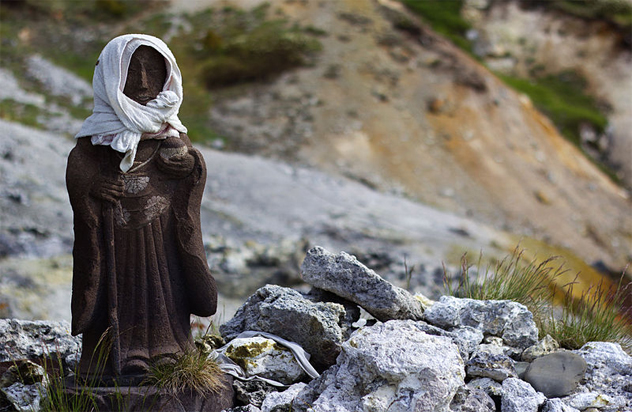
One of Japan’s most sacred sites, Mount Osore (or Mount Osorezan), is one of the entrances to hell. It’s easy to see why, too. The temple sits on a volcanic plain. The air is filled with the smell of sulfur, the pockmarked ground spits and blows steam and hot water, and the nearby lakes have been turned a sickly color by the same sulfur that taints the air.
It also bears some striking similarities to the long-held depiction of the entrance to the afterlife. It’s surrounded by a river and eight mountains, and the pebbles along the side of the river are supposedly put there by the souls of dead children and babies, who are struggling to build a cairn so their spirits can move on. Statues around the complex depict Jizo, the protector spirit that tries to keep evil away from the children and their little piles of rocks. Parents who have lost children often bring pebbles to the site as an offering in the hopes that they’ll be used in the spirit bridges.
The children’s attempts are in vain, though, and their penance for dying before their parents is to be haunted by the evil demons that keep knocking down the piles of stones they make. And the temple, the beach, the barren, desolate landscape . . . it’s all covered with gifts that parents have brought to the spirits of their children. Little, colorful pinwheels dot the landscape, along with coins, chocolates, candy, and little toys. They leave gifts for Jizo, too—shoes, mostly, to help protect him as he chases the evil away from the children.
During the shrine’s festivals, women called itako commune with the spirits of the dead, bringing their messages back to the living who have come to see them. The women aren’t religious, but they’re given their gift supposedly because they lack another gift: sight.
According to tradition, the little bridge of Mount Osore is everyone’s destiny. It crosses to the afterlife, and those who have lived well will cross it easily, while those who have lived an evil life will not be able to see it.
3Tanah Lot
Indonesia
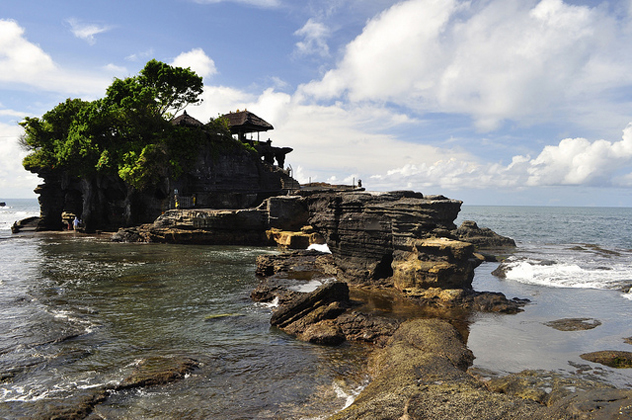
Tanah Lot is perhaps one of the most beautiful locations for a Hindu shrine . . . as long as you don’t mind the snakes. They’re not just snakes, either—they’re sea snakes, and some are incredibly deadly.
According to the legend, Tanah Lot was first settled by a Hindu wanderer named Danghyang Nirartha. After he built the sea temple on the rocky outcropping of the Balinese coast, the local king grew incredibly jealous. The king wanted to get rid of the missionary and sent orders that Nirartha was to leave the island and the temple. When he couldn’t hold out against the might of the king any longer, Nirartha turned his shawl into sea snakes, tasking them with protecting the temple while he was gone.
The snakes are still there, and during low tide, the brave can get close to the rocky island base and beach where they make their home. Still considered the guardians of the temple, the silver-and-black sea snakes are potentially deadly. And more sad than terrifying is the potential fate of Tanah Lot. Its perch on the ocean rocks has made it susceptible to erosion, and in the 1980s, measures were taken to help ensure that the temple won’t eventually fall into the water. Part of the restoration project included replacing a good amount of the island with fake rock.
2Preah Vihear
Cambodia
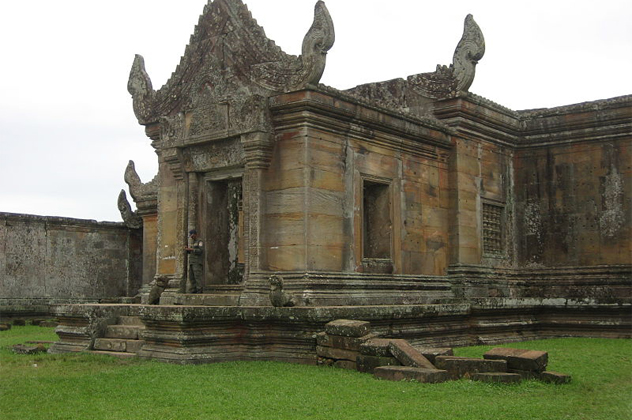
There are no giant snakes, sacred rats, or unsettling stories with this one—what makes this temple absolutely terrifying is the idea that you could very well be taking your life in your hands to visit it.
The temple sits on the Cambodian plain near the border with Thailand. Dating back to the 11th century, it’s an extremely well-preserved example of Khmer architecture, all the way down to the layout and the stone carvings that cover the temple. Now a UNESCO World Heritage Site, the problem is that both nations think it belongs to them.
Archaeologists and park rangers tasked with documenting and preserving the site are used to the sights and sounds of gunfire around the temple. It’s only a few hundred feet from the border between Cambodia and Thailand, and occasionally, preservation work is interrupted when the conflict gets too bad. In 2011, dozens of people—civilians and soldiers alike—were wounded in attacks with at least seven casualties. The problems started in earnest when the two nations realized that the 2008 UNESCO designation had the potential to bring in a decent amount of tourist spending, and both wanted to claim that. A century-long conflict escalated overnight.
The temple is on a site that’s been sacred since at least 893, when the first monuments were built. Archaeologists find the temple, which is dedicated to Shiva, an even more impressive structure than the more well-known Angkor Wat, but the conflict needed to be settled first. When France and Siam drew borders between the two countries in 1904, they weren’t incredibly clear about which side the temple was on, which left a huge portion of land as contested territory. Conflict went all the way to The Hague.
In 2013, The Hague gave the temple to Cambodia in an interpretation of an earlier 1962 ruling that had also favored Cambodia. How peaceful the resolution is remains to be seen.
1Awashima Jinja
Japan

Dolls play a huge role in Japanese culture. They’re not just toys—they’re used in rituals and ceremonies for purification and prayer, along with being a treasured gift for everyone from a newborn child to diplomatic ambassadors. Some are highly collectible, and they’re not just treasured—they’re nearly sacred.
The shrine at Awashima Jinja is geared toward women who go there to pray on matters like health and fertility. They also go there to leave the dolls that their daughters have outgrown because of the belief that a doll that’s improperly disposed of might come back to haunt the family.
The shrine is covered with dolls. And not just dolls but statues and figurines as well, many of them once treasured possessions. And everyone knows just how creepy dolls can be, especially those that are no longer loved or cherished. There are thousands upon thousands of dolls at the temple.
Some dolls are thought to be hosts for human souls, and looking into the dead, staring eyes of those that are no longer needed, it doesn’t seem like the idea is that far-fetched. Every year, the shrine hosts a festival in which some of the dolls are piled into boats and launched into the nearby ocean. Eventually the boats—and the dolls—will sink, and it’s thought that they’ll take bad luck and misfortune with them to the bottom of the ocean.
Other dolls are brought to the shrine as offerings—some are given in the hopes of gaining some good luck with a new baby or conceiving a child. And many of the dolls are given a strangely human-esque ending; once they’re absolved of sin by a priest, they’re given to the fires in a ceremonial funeral.
+Bullet Baba
India
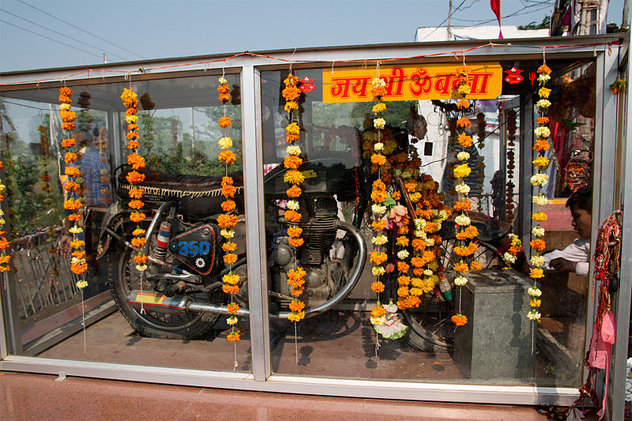
Ever since its installation, thousands of people have some to visit the the shrine of Bullet Baba. It’s not an ancient site—the legend only started in 1988—but it’s incredibly popular.
On December 2, 1988, a local man named Om Singh Rathore was killed when he crashed his motorcycle into a tree. After the accident, local lore says that his motorcycle kept mysteriously returning to the place of the accident. After attempting to move and secure the bike elsewhere, they just decided to erect a shrine to it. The spirit of Om, who had been incredibly proud of his bike, was blamed for not wanting to be parted from it even in death.
Now, the shrine, with its Royal Enfield Bullet and tree decorated with offerings left by visitors, is at the center of regular pilgrimages and a yearly celebration. On Om’s birthday, thousands of people gather and partake in more than a little bit of opium and alcohol. Bizarrely, other shrines have begun springing up across the countryside.
The idea is twofold. Not only is there a pretty neat legend associated with it, but there’s a very sobering reminder that goes along with the bike. The rate of traffic accidents and fatalities is high in the area, and the shrine serves as a very constant reminder of the consequences of drinking and driving. According to local law enforcement, the shrine seems to be doing its job, and numbers of fatal accidents have decreased. Still, one of the frequent visitors to the shrine is Om’s son, born two months after his death—and if that doesn’t deter drinking and driving, nothing will.








